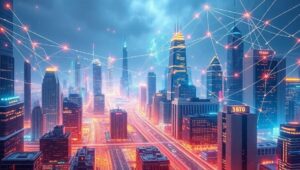The “Internet of Everything”: Where Do We Draw the Line? (2028 Debate)
The year is 2028. The “Internet of Everything” (IoE) has moved beyond a buzzword and become a tangible reality. Our homes, vehicles, cities, and even our bodies are increasingly interconnected through a vast network of sensors, devices, and data streams. But as we integrate technology into every facet of our lives, a crucial question arises: Where do we draw the line?
The Promise of a Hyper-Connected World
The IoE promises unprecedented efficiency, convenience, and innovation. Imagine:
- Smart Homes: Appliances that anticipate your needs, energy grids that optimize consumption, and security systems that proactively protect your property.
- Autonomous Transportation: Self-driving vehicles that reduce accidents, optimize traffic flow, and offer mobility to those who cannot drive themselves.
- Smart Cities: Urban environments that leverage data to improve public services, reduce pollution, and enhance the quality of life for residents.
- Healthcare Revolution: Wearable sensors that monitor vital signs, personalized medicine tailored to individual genetics, and remote patient monitoring that improves access to care.
These are just a few examples of the potential benefits of a fully realized IoE. However, these advancements also present significant challenges that demand careful consideration.
The Looming Concerns
Despite the potential benefits, several concerns need addressing as the IoE expands:
- Data Privacy: With every device collecting and transmitting data, the risk of privacy breaches and mass surveillance increases. How do we protect personal information in a world of ubiquitous sensors?
- Cybersecurity Threats: An interconnected system is only as secure as its weakest link. A single vulnerability could potentially compromise entire networks, leading to widespread disruption and even physical harm.
- Ethical Considerations: Algorithmic bias, autonomous decision-making, and the potential for job displacement raise complex ethical questions. How do we ensure fairness, transparency, and accountability in an increasingly automated world?
- Digital Divide: As technology becomes more integrated into daily life, those without access to the internet and digital literacy skills risk being left behind. How do we bridge the digital divide and ensure equitable access to the benefits of the IoE?
The 2028 Debate: Defining the Boundaries
These concerns have fueled a global debate about the limits of the IoE. Where do we draw the line between innovation and intrusion, efficiency and exploitation, convenience and control? The answers are far from simple.
- Regulatory Frameworks: Governments around the world are grappling with the challenge of regulating the IoE. Should there be strict limits on data collection and usage? What standards should be in place to ensure cybersecurity? How do we balance innovation with consumer protection?
- Ethical Guidelines: Industry leaders, ethicists, and policymakers are working together to develop ethical guidelines for the design and deployment of IoE technologies. These guidelines aim to promote responsible innovation and minimize the risks of unintended consequences.
- Public Awareness: Educating the public about the benefits and risks of the IoE is crucial for fostering informed consent and democratic participation. Citizens need to understand how their data is being used and have the ability to make informed choices about their level of connectivity.
Conclusion: Navigating the Future of the IoE
The “Internet of Everything” has the potential to transform our lives in profound ways. However, realizing this potential requires careful planning, open dialogue, and a commitment to addressing the ethical, social, and security challenges that lie ahead. As we move closer to a fully connected world, it is essential that we draw the line in a way that protects our values, preserves our freedoms, and promotes a future where technology serves humanity, rather than the other way around.




